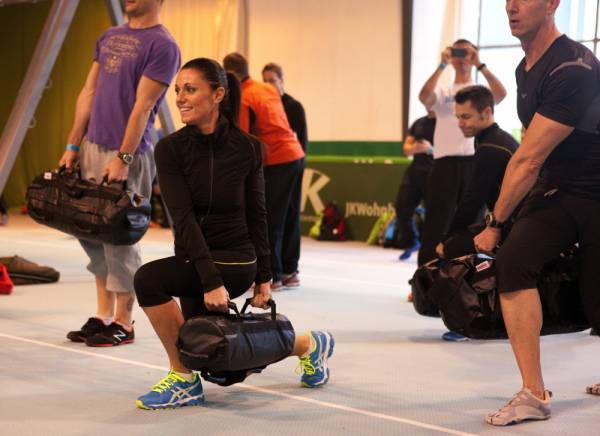I’ll be honest – most of my adult life has not been spent dealing with fitness. As a physical therapist, I thought there was obviously a carryover from one area to the other, but until recently I had no idea how much.
The Challenge of the Fitness Professional
Now that I am more involved in the fitness industry, I am intrigued by the concepts of physical therapy leaking over into fitness. Current fitness professionals have it tough. I had a good idea that people come to fitness pros because they want to lose body fat, look better, and get stronger. What I didn’t appreciate is the challenge that fitness professionals also face in helping people with chronic injuries.
Trying to accomplish all these goals can be more than overwhelming when it comes to developing a good program. Understanding what works, what doesn’t, and maybe even why these things do or do not work can be difficult.
Can We Bridge Fitness and Therapy Concepts?
One of the concepts I have been most intrigued by is the popularity of crawling. Crawling has been promoted as necessary to the proper development of the nervous system in adults. However, the question must be asked, do we all crawl the same and is crawling really necessary to our development?
Research suggests that the sequence of skill acquisition of crawling and creeping is even more variable than previously believed….they also found infants use different crawling/creeping patterns from week to week and even test cycle to test cycle.1
So, it may seem we don’t all crawl the same and our developmental strategies do change from week to week. Does this mean we are going to develop neurological gaps in our adulthood?

According to an article in Scientific American/, native cultures may not even have their children crawl:
According to anthropologist David Tracer of the University of Colorado at Boulder, babies of the Au hunter-gatherers of Papua New Guinea do not go through a crawling stage. Instead their parents and other caregivers carry them until they can walk. Yet Au children do not appear to suffer any ill effects from skipping this phase. In a presentation given to the American Association of Physical Anthropologists in Chicago this past April, Tracer argued that, in fact, not crawling may be entirely normal and possibly even adaptive.2
If you are a fan of crawling, am I asking you abandon the concept? Absolutely not. I think crawling has many benefits, from building good core and shoulder stability to the important cross patterning that is taught. In fact, it is the cross patterning rather than infancy-to-adult development that I believe makes crawling beneficial. But my more immediate concern is that people only recognize cross patterning when it comes to ground-based activities.
The Moral of the Story
Cross patterning is based on the concepts of proprioceptive neuromuscular facilitation, or simply PNF. Many may believe PNF is just about contract-relax strategies, but it is far more complex.
From a therapeutic stand point PNF is designed to:
- Increase the patient’s ability move or remain stable.
- Guide the motion by proper grips and appropriate resistance.
- Help the patient achieve coordinated motion though timing.
- Increase the patient’s stamina and avoid fatigue.3
How can this help the fitness professional? Understanding that the body works naturally in spiral and diagonal patterns helps us promote true functional movement. In general, PNF exercises combine movements in all three planes – sagittal, frontal, and transverse.
“[M]y more immediate concern is that people only recognize cross patterning when it comes to ground-based activities.”
This may be related to why crawling has become so popular. Most strength training tends to ignore our real-life movement patterns and be largely sagittally based or based in a singular plane. Crawling does encourage the principles of PNF and base multi-planar training, but again, this philosophy should extend to many areas of our strength and fitness development.

Implement Cross Patterning Progressions in Programming
That is why I believe in the concepts on which Dynamic Variable Resistance Training (DVRT) is based. By manipulating not just load, but variables such as holding and body positions, we create the ability to have more standing and complex spiral and diagonal patterns.
The challenge is to understand applying these concepts must be incremental. Just as with load, volume, or density, the increase of complexity in cross patterning must be introduced slowly. Otherwise, we end up building dysfunction rather than creating more efficient and effective human movement.
“The challenge is to understand applying these concepts must be incremental.”
In the effort to introduce cross pattern concepts incrementally (since they require more coordination), we, as instructors, tend to focus on either hold position or body position first. But here are a few examples of how we can change body position in some of the most classic movements to introduce a more cross pattern challenge.
Changing load position can be very useful in movements that tend to be more complex, such as lunges, step-ups, and movements in different planes other than sagittal. Here are some ways to utilize load position for cross patterning.
The final stage is to combine both elements of holding and standing position. These are truly athletic type of drills that challenge not just strength, but coordination, as well.
I know what you might be thinking, “But will I get strong?” I wondered the same thing until I used these methods to fix a rather debilitating low-back injury. I was shocked at how weak I was. But by sticking with these concepts, I not only regained my functionality, but also now have good strength in lifts I never even trained before.
You will have to try them for yourself. And if you do, post your experiences to the comments below, along with any questions you might have.
References:
1. Effgen, S. Meeting the Physical Therapy Needs of Children./ Philadelphia: F. A. Davis Company, 2005.
2. Wong, K. “Crawling May Be Unnecessary for Normal Child Development.” Scientific American. June 15, 2009
3. Adler, B., and Buck, M., PNF in Practice. New York: Springer, 2003.
Photos 1 & 2 courtesy of Shutterstock.
Photo 3 courtesy of Ultimate Sandbag Training.
Take a look at these related articles:
- How and Why to Use All 3 Planes of Motion
- DVRT: A Universal System For Fitness Professionals
- Build Your Original Strength Through Crawling
- What’s New on Pulse Beat Fit Today






